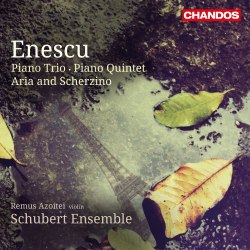| 
|
George ENESCU (1881-1955)
Piano Quintet, Op.29 (1940) [33:44]
Piano Trio (c.1911-16) [21:11]
Aria and Scherzino (c.1908) [5:23]
Remus Aziotei (violin) (aria)
Schubert Ensemble (trio, quintet)
rec. October 2012 (Piano Trio) and January 2012 (remainder), Potton Hall, Dunwich, Suffolk
CHANDOS CHAN10790 [60:44]
Having embarked on their Enescu chamber series with the two Piano Quartets, it was inevitable that the Schubert Ensemble would soon hit the troubled area of those works that were found many years after Enescu’s death - works, moreover, that inevitably aren’t represented by an edition sanctioned by the composer. That is not an insoluble problem, certainly not in the case of the Piano Quintet, even though it remained unknown during Enescu’s lifetime, and he never heard a performance. Its premiere occurred in the 1960s. Martin Anderson is admirably precise when he writes in his notes of the ‘plastic polyphony’ that Enescu pursues in this largely bipartite work, though its further sub-division offers plenty of room for textual and tempo modification and contrast.
What an excellent work this is, full of a profuse amount of material, subject to transformation and a constant sense of movement and flux. At first hearing - maybe at second and third too - one feels that there is simply too much happening for the purposes of motivic clarity. Set against that, in the long and expressive March theme in the Andante sostenuto e cantabile section, you have Enescu at his most pregnant and poignant. The work dates to 1940, after all. In this section the music shades to a Tennysonian Lotus Land. Whilst Brahms is often cited in relation to Enescu’s chamber music, it’s in reality the long arm of the French School that still has him in its thrall - deftly refined. This is a quality that alternates with more vigorous writing in the subsequent fast second panel of the work. Sweeping and well-integrated, with just a few hints of folkloric influence - though nothing like to the extent of the violin pieces - this work retains its characterful colour and energy to the last. It’s played with tremendous conviction by the Schubert Ensemble.
The Piano Trio in A minor was written somewhere between 1911 and 1916. It too has had a problematic history and is performed in an edition by Pascal Bentoiu but revised by the Schubert Ensemble. They have attempted to iron out some of the blemishes in that earlier edition. The ensemble pays due tribute to Bentoiu, and for his vivid work in restoring the Trio. The Piano Trio is a much more straightforward work than the Quintet. Its Francophile inheritance is that much more pronounced. Yet it’s surprising to hear the variation second movement, as variation form is not something often encountered in Enescu’s music. There’s an especially personable Siciliano section, as well as hints that Enescu knew his Ravel. The finale opens with a funereal section, one that feels almost sepulchral in its density, but it soon accelerates into an energetic final section punctuated with lyrical interludes.
Though written for competition purposes - it was most likely written for a violin-making competition in 1908 - the Aria and Scherzino should certainly not be glossed. This is cast for solo violin, string quartet and double-bass and is absolutely lovely. It’s deftly written, and has a gorgeous melody in the Aria. It’s been edited by the indefatigable Sherban Lupu, whom some will know as a hero of the wrist-cripplingly virtuosic violin music of the Moravian Heinrich Ernst.
Potton Hall was a well-chosen venue for this ensemble, which has served Enescu with great dedication and skill.
Jonathan Woolf
 |
 |
|
